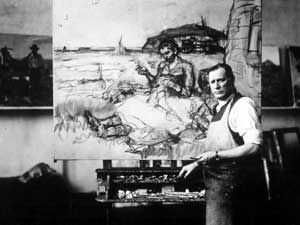
"Harvey Dunn was born on March 8, 1884 on a homestead farm near Manchester, South Dakota. The young man’s talent was first recognized by Ada Caldwell, an art instructor at South Dakota Agricultural College (presently South Dakota State University), which Dunn attended during 1901-1902. Urged by Caldwell, Dunn pursued his artistic studies at the Art Institute of Chicago under the instruction of Howard Pyle in Wilmington, Delaware.In 1906, after two years with Pyle, Dunn established his own studio in Wilmington and immediately began a successful career in illustration. He was a prodigious painter, able to produce (on one occasion) fifty-five completed paintings in eleven weeks for various clients. A contemporary described his style in these terms, “He literally attacked a canvas&Sometimes I thought he would impale the painting with his brush.” In addition to his illustrations for books, Dunn’s work by then was appearing regularly in such magazines as Collier’s Weekly, Harper’s, The Saturday Evening Post, and Scribner’s.The years before the country’s involvement in World War I turned out to be Dunn’s most prolific period as an illustrator. His experiences at the front as one of eight artist-correspondents with the American Expeditionary Force in Europe were a turning point for the artist. Dunn’s interest in commercial illustration declined on his return to the United States. Instead, the artist envisioned working for several years for the War College committing to canvas his sketches of the battlefields of Europe. Unfortunately, demobilization occurred at a rapid pace, and Dunn’s project was rejected. It became the big heartbreak of his life. However, Dunn was able to salvage part of his ambitious plan; in 1927, he began to paint covers with military themes for The American Legion Monthly magazine. The majority of Dunn’s war sketches are now housed at the Smithsonian Institution in the National Museum of American History in Washington, D.C.Later in life Dunn remarked: “The most fruitful and worthwhile thing I have ever done has been to teach.” Dunn became an influential and revered teacher; students referred to him as “Mr. Dunn” as a sign of respect and admiration. The majority of Dunn’s students were either graduate level painters or professional illustrators. Dunn was not interested in teaching painting techniques. His approach was philosophically oriented—he spoke about spirit, emotions, and discourse at length. He discussed his philosophy of life and art, offered group criticism, and strode from easel to easel discussing each student’s work in turn.Dunn’s most inspired teaching was probably achieved at the Grand Central School of Art, located on the top floor of Grand Central Station in New York City. His comments were captured by a student during a five-hour class session and were published in 1934 in a slim volume (printed in a edition of only 1000) entitled An Evening in the Classroom. Dunn was a demanding teacher and at times a harsh critic. He believed in preparing his students for the harsh realities and intense competition of the commercial world. Talent was not enough. As he once said, “If you ever amount to anything at all, it will be because you are true to that deep desire or ideal which made you seek artistic expression in pictures.”
Here is the little book for you to download as a PDF-file:
www.robolus.com/h.dunn-eveningclassroom.pdf

